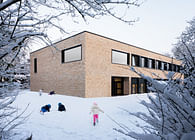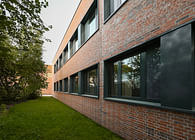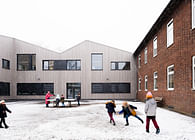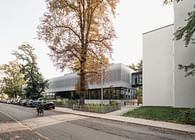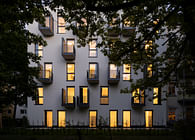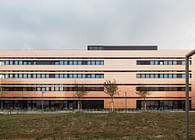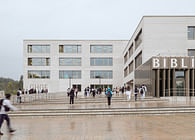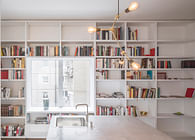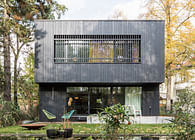
Comprehensive School with Upper Secondary Level and Three-field Sports Hall in the Lusatia region
Lusatia, a former lignite mining region, is facing the challenges of a profound structural transformation. To retain young families in the area, more educational offerings are being developed – not only in elementary education but now also in secondary schools. The Spree-Neisse district, located in the eastern part of Brandenburg along the Polish border, has paved the way for a comprehensive school with an upper secondary level and a three-field sports hall. Sehw Architektur, after winning the competition, implemented the project as an inclusive and inspiring learning environment. The expansive building complex is nestled within the rural surroundings of Kolkwitz. It highlights the vastness of the surrounding nature while meeting modern educational standards.
An urban concept in a rural setting
The urban planning concept impresses with its flat, cohesive design, which is divided into several volumes and thus optimally integrated into the landscape. The building ensemble spreads extensively across the site, with its structure responding to factors such as accessibility, noise pollution and topography of the site. The one- and two-storey building sections are connected by generous terraces, giving the complex an inviting and balanced appearance. This arrangement skilfully mediates between the nearby village and the surrounding open landscape, creating a seamless transition. If the school is envisioned as a town, the atrium serves as the marketplace. From there, the spacious school boulevard leads to the individual neighbourhoods, the learning clusters. The floor plans spatially reflect contemporary pedagogical learning concepts and allow for future changes thanks to a high degree of flexibility.
Functionality meets aesthetics
Inside, the design captivates due to its clear organisation and flexible spatial structures. General classrooms on the upper floor provide a quiet learning atmosphere, while specialised rooms, administration and communal areas are located on the ground floor. Particularly striking are the cluster units, which create communicative spaces through central learning zones and generous flights of stairs. The roof terraces between the taller building sections can be used as green classrooms, further enhancing the connection between the interior and exterior.
Sustainability and modern technology
The light-coloured brick façade lends the building an elegant appearance, harmonising with the surrounding nature. The material is typical of the region and highly durable. Large ribbon windows provide ample daylight and emphasise the rhythmic structure of the building. In the interior, natural materials such as wood, linoleum and stone dominate the spatial atmosphere. Open louvres in the communal areas and acoustic ceilings in the classrooms ensure optimal conditions for both lively interaction and focused work.
Energy concept
Good indoor air quality, a crucial requirement for effective learning and teaching, is achieved through natural ventilation via manually operable windows. Interactive displays are equipped with CO2 monitors to help control the air quality. Energy-intensive ventilation systems are avoided except in special areas, such as the science laboratories. Heat generated in the rooms is automatically dissipated through natural night-time cooling. The massive monolithic exterior walls and ceilings serve as thermal storage mass for cooling, while night-time cooling vents are integrated into the ribbon windows. Rainwater collected on the roofs and in outdoor areas is absorbed through an extensive rainwater management system, including swales, trenches and infiltration ditches, supporting the natural cooling concept. An air-to-water heat pump provides the building’s heating.
More nature for cooler temperatures
Landscape architecture was an integral part of the general planning from the competition stage. The landscape architecture firm Schönherr, in collaboration with Sehw Architektur, ensured that a large part of the site remained unpaved. Green courtyards, green roofs and reed beds in the outdoor area create a microclimate with natural cooling and ensure a sophisticated rainwater management system. These measures contribute to climate adaptation and make the area pleasant even during the hot summer months. The pupils of the Kolkwitz Comprehensive School can look forward to a variety of outdoor spaces, including an orchard with old apple varieties, expansive lawns, small intimate seating areas, nearly 100 newly planted trees, a greenhouse and shady pergolas, as well as sports areas. The result is an ensemble that seamlessly blends architecture and landscape architecture.
Sustainability as a guiding principle
“We want to use as little technology as possible,” says architect Prof. Xaver Egger. “For example, we’ve integrated openable vents into the ribbon window for night-time cooling. The coolness is stored in the concrete ceilings and released the next day.”
With this project, Sehw Architektur, as the general planner, together with its partners, has created an innovative and forward-thinking educational centre that not only impresses architecturally but also meets the highest standards of functionality, sustainability and inclusion. An innovative school design with green classrooms and lush orchards – learning in harmony with nature!
Status: Built
Location: Kolkwitz, DE
Additional Credits: Design Team: Susanne Boss, Achim Eilmsteiner, Jacqueline Ekteshafi, Andrea Fitz, Maria Peña, Sandra Scheffl, Daniel Spievak, Tatiana Trindade

